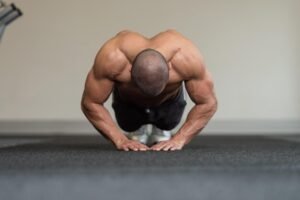Table of Contents
Embark on a transformative journey to carve out that coveted V-taper with the revolutionary world of calisthenics back workout. This blog explores how bodyweight becomes the catalyst for sculpting a powerful and well-defined back. From the versatility of exercises to the engagement of the core in each movement, discover the unparalleled benefits that set calisthenics apart as a game-changer in the realm of back training.
Unveiling the secrets behind calisthenics back workouts, we dive into specific exercises, each meticulously designed to target distinct muscle groups. From the dynamic Scapular Wall Slides to the fluid Hindu Pushup, explore a repertoire of movements that promise to reshape and redefine your back. Join us on this exploration of the extraordinary, where adaptability, accessibility, and innovation converge to revolutionize your approach to back fitness through the lens of calisthenics.
Understanding Calisthenics for Back Workout
Calisthenics, a fitness discipline that transcends the ordinary, emerges as an unparalleled method for forging a robust and muscular back. At its core, calisthenics is defined by fundamental principles that elevate it to the pinnacle of back training, offering a unique blend of simplicity and profound impact.
1. Bodyweight Dynamics: Catalyst for a Robust Back in Calisthenics
Calisthenics, distinguished by its reliance on bodyweight, serves as a potent catalyst for cultivating a robust back. In contrast to traditional weightlifting, which employs external resistance, calisthenics harnesses the manipulation of one’s own body weight, forging a training environment that is dynamic, adaptable, and uniquely effective.
2. Versatility of Calisthenics for Well-Rounded Back Development
Calisthenics stands out for its remarkable versatility in crafting a well-rounded and sculpted back. The myriad of exercises tailored for back development encompasses a spectrum of movements, each strategically designed to target specific muscles. This versatility not only ensures comprehensive muscle engagement but also contributes to the aesthetic appeal of a sculpted physique.
3. Core Engagement in Calisthenics Back Exercises
In calisthenics, core engagement plays a pivotal role, serving as the cornerstone for a holistic approach to strength development, especially in back exercises. As individuals leverage their body weight, the core functions as a stabilizer, extending its influence beyond merely targeting the back muscles, and contributing to overall functional strength.
4. Adaptability and Accessibility in Calisthenics
Calisthenics stands out for its remarkable adaptability and accessibility, catering to individuals across diverse fitness levels. This versatility makes it an excellent choice for fostering continuous growth in back strength and muscle development, whether you’re a beginner or an advanced practitioner.
The Best Calisthenics Back Workout and Exercises
Scapular Wall Slides:
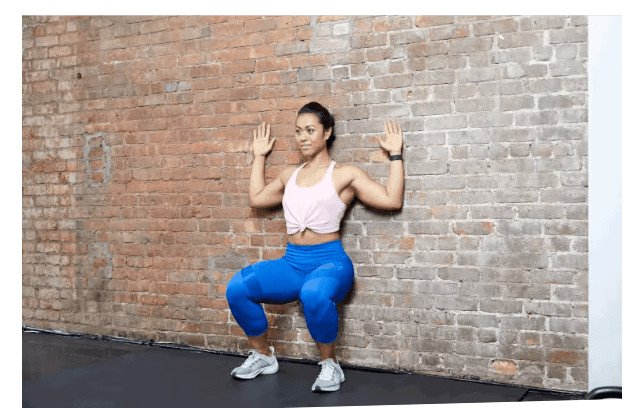
Scapular Wall Slides are a dynamic exercise that enhances back muscle engagement, scapular movement, and shoulder stability. Muscles Engaged: This exercise primarily targets the muscles around the scapula, including the rhomboids, trapezius, and deltoids. It also engages the muscles of the rotator cuff. To perform this calisthenics back workout:
I. Sit against a wall with your palms facing forward.
II. Maintain contact with the wall and slide your hands up and down in a controlled manner.
Benefits:
1.Improved Scapular Stability: The controlled movement against the wall challenges and improves the stability of the scapula, promoting better shoulder mechanics.
2. Enhanced Shoulder Stability: By actively involving the shoulders in the sliding motion, the exercise contributes to overall shoulder stability.
3. Promotion of Scapular Movement: The sliding action mimics natural scapular movement, preventing stiffness and promoting a healthy range of motion.
4. Prevention of Shoulder Impingement: Regular practice can help reduce the risk of shoulder impingement by strengthening the supportive muscles.
5. Use in Rehabilitation: Scapular Wall Slides are often recommended in rehabilitation settings to address shoulder issues and improve scapular function.
6. Variations: The exercise can be modified by using resistance bands or incorporating additional movements to tailor it to different fitness levels and goals.
Incorporating Scapular Wall Slides into a regular exercise routine can contribute to better posture, reduced risk of shoulder injuries, and improved overall upper body strength.
Lying Back Press:
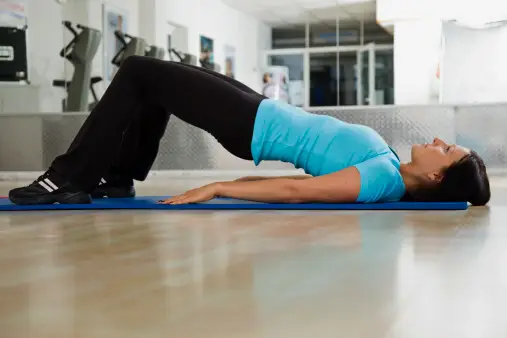
The Lying Back Press is a bodyweight exercise where you lie on your back with arms extended. By squeezing the glutes and engaging the abs to create tension, you perform a pressing motion that targets the back muscles. Muscles Targeted are lat muscles, Upper Back, Glutes etc. To perform this calisthenics back workout:
I. Lie on your back with arms extended straight above your chest.
II. Squeeze your glutes and tighten your abs to create a stable base.
III. Perform a pressing motion, lowering your arms towards the floor and then pressing them back up. Maintain controlled movements to maximize muscle engagement.
Benefits:
1. Posterior Chain Strength: The exercise strengthens the posterior chain, comprising the muscles along the back of the body, from the glutes to the upper back.
2. Emphasis on Upper Back: Targets the upper back for improved posture and a sculpted physique.
3. Overall Stability: The engagement of glutes and upper back muscles enhances overall stability, aiding in better functional movement.
4. Applicability: Ideal for those without equipment, the Lying Back Press offers an effective way to work the back muscles at home or in any setting.
5. Variations: The exercise can be modified by incorporating variations like altering hand positions or adding resistance for progression.
Incorporating the Lying Back Press into a routine contributes to a well-rounded back workout, promoting strength, stability, and muscle development.
Cobra Pose:

The Cobra Pose, also called Bhujangasana, is a yoga pose inspired by the shape of a cobra. It involves carefully lying down on your stomach and lifting the upper body while keeping the lower body grounded. The pose resembles a snake with its hood raised, promoting strength and flexibility. Muscles targeted are back muscles, leg muscles etc. To perform this calisthenics back workout:
I. Begin by lying on your stomach, legs extended, and palms placed on the floor near your chest.
II. Inhale and gently lift your upper body, extending the arms while keeping the pelvis and lower body on the mat.
III. Arch your back, lifting the chest towards the ceiling, and gaze forward or slightly upward.
IV. Hold the pose for a few breaths, maintaining a gentle stretch in the spine.
V. Exhale as you lower the upper body back to the mat.
Benefits:
1. Spinal Flexibility: Cobra Pose stretches and strengthens the spine, enhancing flexibility and promoting a healthy range of motion.
2. Back Health: By engaging the back muscles, it contributes to a strong and resilient back, reducing the risk of discomfort or injury.
3. Improved Posture: Regular practice of Cobra Pose encourages proper alignment and posture by opening the chest and shoulders.
4. Holistic Well-being: As a part of yoga, Cobra Pose incorporates breath control and mindfulness, promoting holistic well-being.
5. Caution: Individuals with back issues should approach this pose with care, avoiding overextension and consulting a professional if needed.
Incorporating Cobra Pose into a yoga routine can be beneficial for overall back health, flexibility, and mental well-being.
Single-arm Suspension Row:
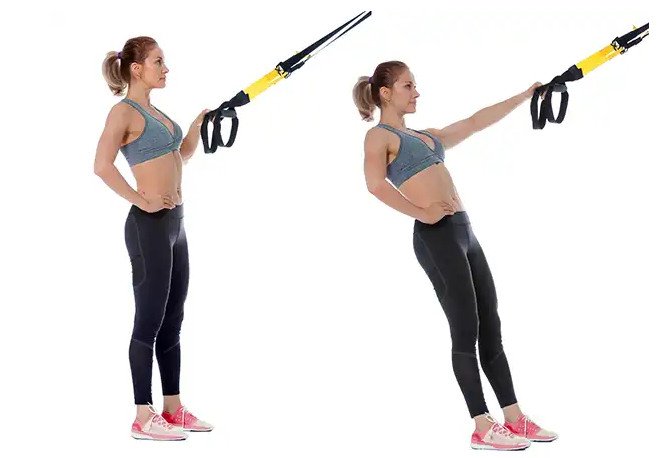
It is a unilateral back exercise that leverages suspension training. It requires pulling your body weight using one arm while the other is suspended, engaging the core for stability. This exercise normally involves using equipment like TRX straps or suspension trainers. Muscles Targeted are Lats, Rhomboids, Core etc. To perform this calisthenics back workout:
I. Begin by setting up the suspension trainer at an appropriate height.
II. Grasp the handle with one hand, facing the anchor point, and extend your arm, leaning back at an angle.
III. Initiate the rowing motion by pulling your body towards the suspended hand, keeping the body straight and stable.
IV. Lower the body back down with control to complete one repetition.
Benefits:
1. Muscle Imbalance Correction: By focusing on one arm at a time, the exercise helps address muscle imbalances that may exist between the left and right sides of the body.
2. Core Stability: The need to stabilize the body during the rowing movement enhances core stability, promoting a strong and resilient core.
3. Targeted Back Engagement: The Single-arm Suspension Row isolates the lats and rhomboids effectively, contributing to a well-rounded back workout.
4. Incorporation: Include this exercise in your training routine to promote unilateral strength, improve muscle balance, and enhance overall back development.
Chin up With Isometric Hold:
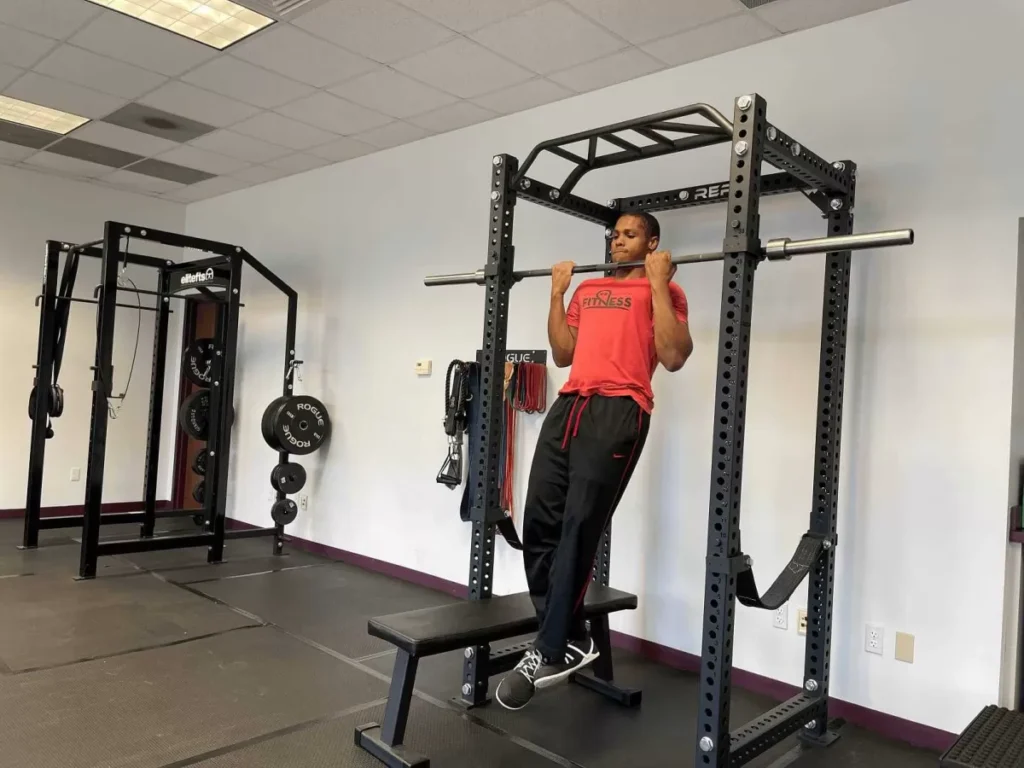
This advanced chin-up variation integrates isometric holds at various points within the movement. As you perform the chin-up, intentional pauses are introduced at different stages, intensifying the difficulty and extending the duration of muscle engagement. Isometric holds can be strategically placed, for instance, at the bottom, midpoint, or top of the chin-up, requiring the muscles to sustain tension without the typical range of motion. Muscles Targeted are Back Muscles, Biceps etc. To perform this calisthenics back workout:
I. Begin the chin-up as usual, pulling your body upward towards the bar.
II. Pause at specific points during the ascent or descent, holding the position statically.
III. Continue the movement with controlled and deliberate pauses, challenging the muscles with prolonged contraction.
Benefits:
1. Time Under Tension: Incorporating isometric holds increases the time under tension, a key factor for muscle growth, endurance, and strength development.
2. Muscle Endurance: The prolonged engagement challenges the muscles to adapt to sustained stress, enhancing endurance over time.
3. Strength Development: By intensifying the challenge, this variation promotes greater strength development in the back muscles and biceps.
4. Training Considerations: Ensure proper form and gradually incorporate isometric holds to avoid overexertion. This variation suits individuals seeking advanced chin-up techniques to further enhance their upper body strength.
Hindu Pushup:
The Hindu Pushup is a fluid and flowing movement that engages the entire back. It involves a sequence of positions reminiscent of the downward dog and upward dog in yoga. Starting in a downward dog position, the body flows through a smooth transition into an upward dog, creating a continuous, wave-like motion. Muscles targeted are entire Back, shoulders, Posterior Chain etc. To perform this calisthenics back workout:
i. Begin in a downward dog position with your hips raised and heels pushing towards the floor.
ii. Transition into an upward dog by lowering your hips, arching your back, and lifting your chest upward, bringing your head and shoulders back.
iii. Return to the downward dog position, creating a seamless and rhythmic flow.
Benefits:
1. Flexibility: The continuous movement enhances flexibility in the back and shoulders.
2. Strength: Builds strength in the entire back and shoulder muscles.
3. Mobility: Improves overall mobility, especially in the shoulder joints.
4. Full-Body Exercise: Acts as a full-body exercise, targeting multiple muscle groups simultaneously.
5. Training Considerations: Suitable for individuals looking to incorporate a dynamic and functional movement into their routine. Beginners may start with modified versions and gradually progress to the full Hindu Pushup.
Superman:
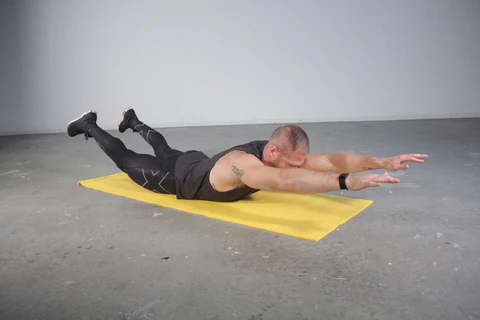
The Superman exercise is a beginner-friendly movement performed by lying on your stomach and lifting both arms and legs off the ground simultaneously. This action engages the lower back muscles, creating a posture resembling the flying superhero position. The primary target, located along the spine, consists of three muscles (iliocostalis, longissimus, and spinalis) that support the spine’s extension. To perform this calisthenics back workout:
I. Lie face down on the floor with arms extended in front of you and legs fully extended.
II. Simultaneously lift both arms and legs a few inches off the ground, keeping your neck in a neutral position.
III. Hold the lifted position briefly, focusing on engaging the lower back muscles.
IV. Lower arms and legs back to the starting position.
Benefits:
1. Lower Back Strength: Strengthens the erector spinae muscles, promoting a robust lower back.
2. Stability: Enhances lower back stability, reducing the risk of lower back pain and improving overall spine support.
3. Prevention: Foundational for preventing lower back pain and promoting a healthy back.
4. Training Considerations: Ideal for beginners due to its simplicity and effectiveness. Can be incorporated into warm-up routines or as part of a comprehensive back-strengthening workout.
Prone Pull:

The Prone Pull is a targeted exercise that focuses on both the upper and lower back muscles. In this exercise, you lie on your stomach and pull your upper body towards an anchor point using your arms. It involves a horizontal pulling motion with an emphasis on engaging the back muscles. Muscles Targeted are Lats (Latissimus Dorsi), the large muscles of the back responsible for the pulling motion and mid-Back Muscles: Includes muscles like the rhomboids and traps, contributing to scapular retraction. To perform this calisthenics back workout:
I. Begin by lying face down on the ground with your arms extended forward, holding onto a fixed anchor point.
II. Initiate the movement by pulling your upper body toward the anchor point, keeping your elbows close to your body.
III. Emphasize scapular retraction, squeezing your shoulder blades together during the pulling phase.
IV. Lower your upper body back to the starting position with control.
Benefits:
1. Scapular Retraction: Emphasizes scapular retraction, promoting proper shoulder mechanics and posture.
2. Full Back Strengthening: Targets the entire back, with a focus on lats and mid-back muscles.
3. Postural Improvement: Contributes to improved posture by strengthening the muscles responsible for scapular movement.
4. Application: Suitable for individuals aiming to enhance back strength, address muscle imbalances, and improve overall posture.
Reverse Snow Angel:
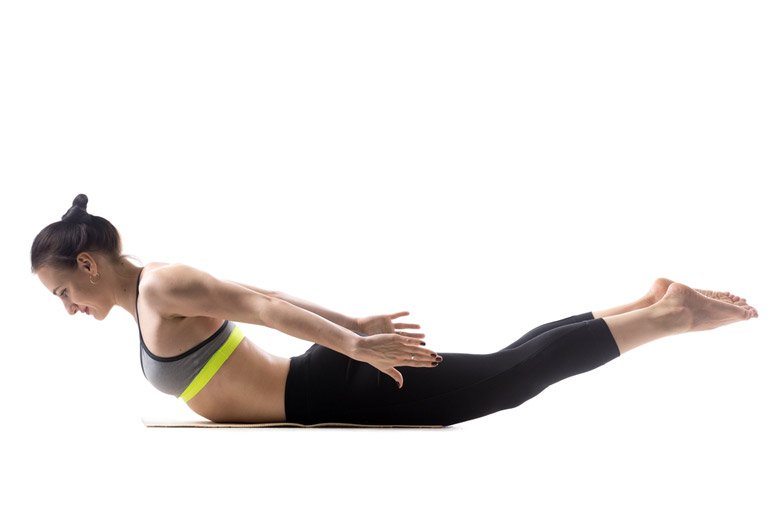
The Reverse Snow Angel is a unique exercise where you lie face down and simulate the motion of a snow angel by moving your arms. This movement specifically targets the muscles of the upper back and shoulders. Muscles Targeted are upper back muscles, shoulder muscles and scapular muscles. To perform this calisthenics back workout:
I. Begin by lying face down on a flat surface, such as a mat.
II. Extend your arms straight in front of you.
III. Simulate the motion of a snow angel by moving your arms outward and then back together in a controlled manner.
IV. Maintain a flat position, engaging your core throughout the movement.
Benefits:
1. Scapular Mobility: Enhances the ability of the shoulder blades to move, promoting overall shoulder health.
2. Upper Back Activation: Targets and activates the muscles between the shoulder blades for improved back strength.
3. Unique Movement Pattern: Provides a distinctive movement pattern, contributing to a well-rounded back workout.
4. Application: Suitable for individuals looking to diversify their back workout routine, improve scapular mobility, and activate the upper back muscles.
Calisthenics Exercises for Back Health:
Calisthenics back workouts incredibly offer a versatile and impactful strategy for enhancing both strength and flexibility in the back muscles. By incorporating a range of movements, these exercises and workouts accommodate individuals at different fitness levels. Here’s an elaboration on the benefits:
A. Tailoring Your Routine to Fitness Levels:
1. Personalization: To maximize effectiveness, it’s crucial to personalize your calisthenics back workout plan according to individual fitness levels and goals. Assessing current fitness capabilities allows for the creation of a tailored approach.
2. Goal Alignment: Understanding specific fitness objectives, whether it’s building strength, improving endurance, or achieving aesthetic goals, ensures that the calisthenics back training aligns with individual aspirations.
3. Adaptability: The plan should be adaptable to accommodate changes in fitness levels over time, allowing for continuous progression.
B. Progressive Intensity and Variation:
1. Importance of Progression: Recognizing the significance of progression is key in calisthenics. Gradually increasing the intensity of exercises ensures that muscles are consistently challenged, promoting growth and development.
2. Diverse Exercises: Incorporating a variety of exercises is essential for a well-rounded calisthenics journey. Diverse movements engage different muscle groups, preventing plateau and enhancing overall back development.
3. Continuous Challenge: Constantly challenging muscles with new variations and increased difficulty levels prevents adaptation, promoting continuous improvement in strength, endurance, and overall fitness.
Designing a calisthenics back workout plan with a personalized approach, mindful of fitness levels and goals, coupled with a commitment to progressive intensity and diverse exercises, lays the foundation for a comprehensive and effective training regimen.
Nutrition for Optimal Calisthenics Back Workout:
A. Pre-Workout Nutrition Strategies:
1. Right Nutrients: Before a calisthenics back workout, it’s essential to focus on the right nutrients. Emphasize a combination of complex carbohydrates and lean proteins to provide sustained energy throughout the session.
2. Maximizing Performance: Incorporating carbohydrates helps replenish glycogen stores in muscles, enhancing endurance. Proteins aid in muscle protein synthesis, preparing the muscles for optimal performance during the workout.
3. Hydration: Hydrate adequately before the session to maintain fluid balance, support metabolic processes, and prevent dehydration-induced fatigue.
B. Post-Workout Recovery Essentials:
1. Nutrient Timing: After an intense calisthenics session, prioritize nutrient intake within the post-workout window. Consume a combination of carbohydrates and protein to replenish glycogen stores and initiate muscle repair.
2. Protein for Recovery: Protein intake is crucial for muscle recovery and growth. Opt for a protein source with essential amino acids to support the repair of micro tears in muscle fibers induced during exercise.
3. Hydration and Electrolytes: Rehydrate with water and consider a beverage containing electrolytes to replenish minerals lost through sweat. Proper hydration supports overall recovery and prevents dehydration-related issues.
Implementing these pre-workout and post-workout nutrition strategies ensures that the body is adequately fueled for optimal performance during calisthenics back workout and facilitates efficient recovery for muscle growth.
From the foundational principles that make calisthenics a beacon in back training to the diverse array of exercises that promise a well-rounded development, this journey is a testament to the transformative power of bodyweight dynamics. As you embrace personalized calisthenics back workout plans tailored to your fitness levels and goals, and indulge in progressive intensity and variation, the V-taper becomes not just an aspiration but an achievable reality.
Furthermore, the holistic approach extends beyond the workout itself, delving into the vital realm of nutrition. Pre-workout strategies fuel your body with precision, and post-workout recovery becomes a crucial ritual for nurturing muscle growth. The synergy between calisthenics and nutrition propels you towards optimal back muscle growth, ensuring a holistic and sustainable path to the V-taper you’ve always envisioned. It’s not just a workout; it’s a lifestyle, and calisthenics back workout is your steadfast companion on the journey to a sculpted and powerful back.
FAQs:
1. What makes calisthenics effective for back training?
Calisthenics utilizes bodyweight dynamics, providing a dynamic and adaptable environment for back development.
2. How can I personalize my calisthenics back workout plan?
Assess your fitness levels, align goals, and ensure adaptability for continuous progression.
3. Why is core engagement emphasized in calisthenics back exercises?
The core serves as a stabilizer, extending its influence beyond targeting back muscles, contributing to overall functional strength.
4. Are calisthenics exercises adaptable for all fitness levels?
Yes, calisthenics is known for its adaptability and accessibility, catering to individuals from beginners to advanced practitioners.
5. What are the benefits of incorporating isometric holds in chin-ups?
Isometric holds increase time under tension, promoting muscle growth, endurance, and strength development.
6. How can pre-workout nutrition enhance calisthenics performance?
Emphasizing the right nutrients, including carbohydrates and proteins, provides sustained energy and supports muscle function during the workout.


